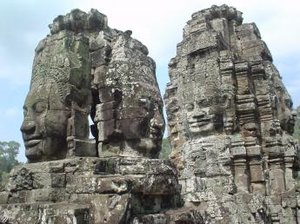Angkor
|
|
| Missing image Angkor_Ruins_from_Space.jpg Angkor viewed from space |
Angkor was the site of a series of capital cities of the Khmer empire for much of the period from the 9th century to the 15th century CE. Their ruins are located amid forests and farmland to the north of the Great Lake (Tonle Sap), near present day Siem Reap, Cambodia, and are a UNESCO World Heritage Site. The temples of Angkor, now partially restored, constitute the premier collection of examples of Khmer architecture. Visitor numbers approach one million annually.
| Contents |
History
Over a period of 300 years, between 900 and 1200 AD, the Khmer empire produced some of the world's most magnificent architectural masterpieces on the northern shore of the Tonle Sap, near the present town of Siem Reap. Most are concentrated in an area approximately 15 miles east to west and 5 miles north to south, although the Angkor Archaeological Park which administers the area includes sites as far away as Kbal Spean, about 30 miles to the north. Some 72 major temples or other buildings dot the area.
The principal temple, Angkor Wat, was built between 1112 and 1150 by Suryavarman II. With walls nearly one-half mile on each side, Angkor Wat portrays the Hindu cosmology with the central towers representing Mount Meru, home of the gods; the outer walls, the mountains enclosing the world; and the moat, the oceans beyond. The later capital of Angkor Thom, built after the Cham sack of 1177, has at its centre the Bayon. Construction of Angkor Thom coincided with a change from Hinduism to Mahayana Buddhism. Temples were altered to display images of the Buddha, and Angkor Wat briefly became a Buddhist shrine. A subsequent Hindu revival included a large-scale campaign of desecration of Buddhist images, before Theravada Buddhism became established from the 14th century.
During the 15th century, nearly all of Angkor was abandoned after Siamese attacks, except Angkor Wat, which remained a shrine for Buddhist pilgrims. The great city and temples remained largely cloaked by the forest until the late 19th century when French archaeologists began a long restoration process. From 1907 to 1970 restoration of Angkor was under the direction of the Ecole Française d'Extrême-Orient, which worked to clear away the forest, repair foundations, and install drains to protect the buildings from water damage. After the end of the civil war, work began again, and since 1993 it has been jointly co-ordinated by the French, Japanese and UNESCO through the International Co-ordinating Committee on the Safeguarding and Development of the Historic Site of Angkor (ICC), while Cambodian work is carried out by the Authority for the Protection and Management of Angkor and the Region of Siem Reap (APSARA), created in 1995. The Some temples were carefully taken apart stone by stone and reassembled on concrete foundations. Since the end of the civil war, international tourism to Angkor has increased, posing additional conservation problems.
2001 saw the release of the movie Tomb Raider, filmed on location at various Angkor sites.
Sites
The area covers many significant archaeological sites, including:
Awatnagabridgesunrise01.JPG
- Angkor Thom
- Angkor Wat
- Baksei Chamkrong
- Banteay Kdei
- Banteay Samre
- Banteay Srei
- Baphuon
- the Bayon
- Chau Say Tevoda
- East Baray
- East Mebon
- Kbal Spean
- the Khleangs
- Krol Ko
- Lolei
- Neak Pean
- Phimeanakas
- Phnom Bakheng
- Phnom Krom
- Prasat Ak Yum
- Prasat Kravan
- Preah Khan
- Preah Ko
- Preah Palilay
- Preah Pithu
- Pre Rup
- Spean Thma
- Srah Srang
- Ta Prohm
- Ta Som
- Ta Keo
- Terrace of the Elephants
- Terrace of the Leper King
- Thommanon
- West Baray
- West Mebon
References
- Freeman, Michael and Jacques, Claude. Ancient Angkor. River Books, 1999. ISBN 0834804263.
- National Review: In Pol Pot Land: Ruins of varying types Sept 29, 2003 (http://www.findarticles.com/p/articles/mi_m1282/is_18_55/ai_109411352)
- [http://portal.unesco.org/culture/en/ev.php-URL_ID=2672&URL_DO=DO_TOPIC&URL_SECTION=201.html UNESCO:
International Programme for the Preservation of Angkor] Accessed 17 May 2005.
External links
- Yellow Pages Cambodia 3D Map (http://www.yellowpages-cambodia.com/maps/angkor-temples-map.aspx) Virtual 3D Tour of the Angkor temples
- The New Tomb Raiders (http://members.ozemail.com.au/%7Erodeime/cambodia/) Article discussing the rising pressure from tourism by Roderick Eime
da:Angkor de:Angkor es:Angkor fr:Angkor he:אנגקור id:Angkor ja:アンコール遺跡 nl:Angkor sv:Angkor

